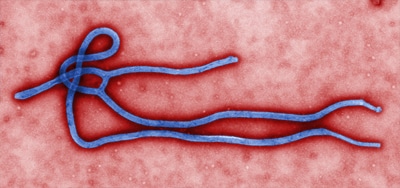2014: CDC laboratories produce first genomic sequence of Liberian Ebola

Based on current evidence, scientists believe the Ebola virus, seen here in a colorized transmission electron micrograph, originates in animals (zoonotic).
During an Ebola outbreak – such as the 2014-2016 West Africa outbreak, the largest in history — understanding whether the virus changes as it spreads through different populations can help responders know what treatments to use and also help research laboratories develop new tools to speed diagnosis in the field.
In 2014, CDC scientists had access to genetic sequences from Guinea and Sierra Leone that had been published by other researchers. But the return to the United States of two American patients with Ebola infection underscored that no genetic sequences existed of the Liberian virus. After CDC received samples from patients infected in Liberia, scientists immediately applied diagnostic tests and began the process of sequencing the genetic material in the samples.
Less than 72 hours after the first samples arrived, scientists had not only initial test results confirming that the patients were infected with Ebola virus, but also had the first detailed genetic sequencing of the Liberian virus. The genetic sequence information confirmed the Liberian viral samples were 99% identical to the virus circulating in Guinea and Sierra Leone. Another important detail that emerged was that the virus in the 2014 epidemic was 97% similar to the virus that first emerged in 1976.
Advanced molecular detection methods (AMD), like next-generation sequencing, can show exactly where mutations are occurring in a pathogen. But in an outbreak, it is equally important to know if no mutations are occurring. This information helps doctors in the field have confidence in the treatments and interventions they’re using.
“Our aim is to design better tools to diagnose this illness. As a virus mutates, it can change in such a way that existing tests no longer pick it up. Thankfully, these data seemed to indicate the virus was not changing in this outbreak,” said one of the CDC laboratory scientists.
Further analysis of additional samples also allowed CDC scientists to look to see if any other factors—such as other simultaneous infections—contributed to the severity of the illness. “We couldn’t do that before AMD technology,” scientists said.